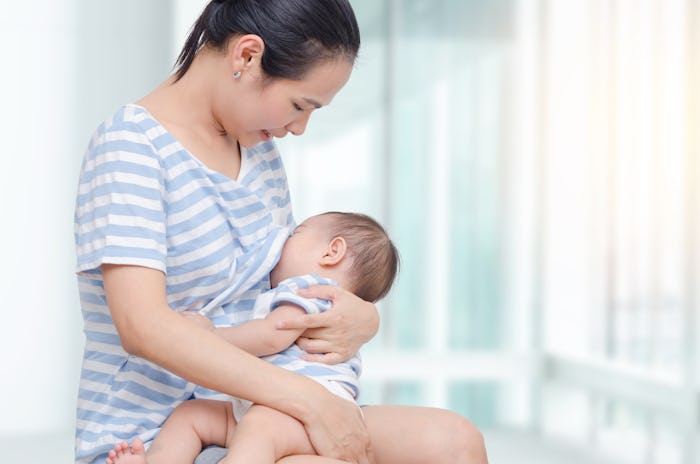Life

Here's What Breastfeeding Is Like In Asia
Breastfeeding is a hot button issue, that's certain. There's a lot of venom thrown on all sides, and it's hard to see the forest for the trees sometimes. But what's it like in other places, like China or India? What's breastfeeding like in Asia in general?
There are 50 countries in Asia, from Turkey to Japan, Bahrain to Bangladesh. To quantify one piece of motherhood into a neat little graph would be doing it a major disservice. Overall, though, the rates of breastfeeding have declined over the past few decades, according to the Asia Pacific Population Journal. The reasons for the decline are as varied as the countries they're occurring in — everything from cultural practices, which may lead to the decreased ability to breastfeed, to demand placed on mothers to return to work quickly after having a baby. A noted few exceptions like Japan, South Korea, and Bangladesh, have all seen a rise in breastfeeding rates in the past 10 years. In some cases, they have outpaced the west by a large margin.
In China, for instance, the rates have hovered between 16 percent of mothers in the city breastfeeding and 30 percent of mothers in rural areas who breastfeed, noted Bloomberg News, and it may be in part to a confinement period that is part of the maternal health cultural tradition in China.
During this period, according to Lin Tan, a Hainanese living in Hong Kong, "you're really locked away. Your mother-in-law and sometimes your mother bring you food and do your housework, or they hire someone to do the housework for you. They give your baby formula so that you don't overtax yourself." For women like Tan, this can have a deleterious effect on milk supply. "My milk never fully came in. I only nursed my son once," she says in an interview with Romper.
According to Tan, this is the case for many breastfeeding mothers in China, but that "there's a strong movement that you see the government backing towards breastfeeding. There are a lot of women on Weibo (a social media website in China) who are posting tips on breastfeeding, or their stories. But it's not like in Europe or the U.S.; all the women cover up under a modesty cover if they go out."
Bloomberg wrote that the Chinese government is pushing hard against the heavy marketing capabilities of the formula manufacturers, but with only limited success. Even after a problem with the milk in the formula which led to the deaths of six infants and to the illness of nearly 500,000 babies, the drive for formula just shifted course, forcing women to look for formula made outside of China.
In Korea, however, even though they experienced a period in the twentieth century where the rates of babies who were breastfed exclusively declined steadily, recently, they've been on the uptick, with the rate of mothers who exclusively breastfeed their babies up to 6 months of age now at about 30 percent. For years before the twentieth century, it was pretty common for moms in Korea to breastfeed well beyond the first two years. Now, they're getting back to that. Even though breastfeeding out in the open is frowned upon, according to Korea Portal, public places go out of their way to create safe spaces to feed your child. Malls, shopping centers, grocery stores, and even colleges have family rooms for breastfeeding mothers to go to when they need to feed their child or pump.
In Japan, breastfeeding is not only encouraged — pretty much every biological mother does it, at least a little bit. According to the International Breastfeeding Journal, 95 percent of babies are breastfed at least part-time. British-Japanese web designer mom, Satsuri (Suri) Hiramoto, lives in Tokyo and tells Romper that "in the hospital, they tell you to breastfeed, so you do. You go home, and you keep doing it, because everyone told you it was the best thing to do, which is good and bad." When asked about nursing in public, she says, "We mostly cover up, and even though old ladies like to chat you up if they see what you're doing, it's not to throw barbs. They really just want to gawk at the chubby baby legs. But even if you get a bit of a flash happening, we're too polite to say anything, and everyone looks everywhere but at your boob while you cover back up." Japan now has 25 baby-friendly hospitals, and 40 registered lactation consultants, reported La Leche League, and this is probably a big reason why breastfeeding is so successful in the region.
In South Asia, things are a bit different. According to the International Breastfeeding Journal, rates of breastfeeding in India are considered "sub-optimal" given the health needs of the children of the region. In Thailand, only 12 percent of mothers breastfeed, and the rates are similar in Myanmar, and across Southeast Asia, according to Health Policy Planning. The reasons for this startling statistic range from cultural association of store-bought milk being healthier, to the need to return to work and lack of support.
So it seems that no matter where you are in the world, breastfeeding is a challenging issue to balance in a culture, community, and personal life. Whether you're in Minneapolis or Myanmar, your reasons for not breastfeeding may be more similar than different, and one thing's for certain — moms across the globe just want their babies to be happy and healthy, no matter how they're fed.